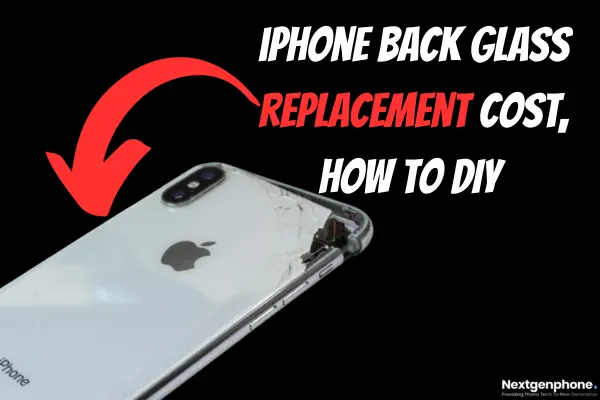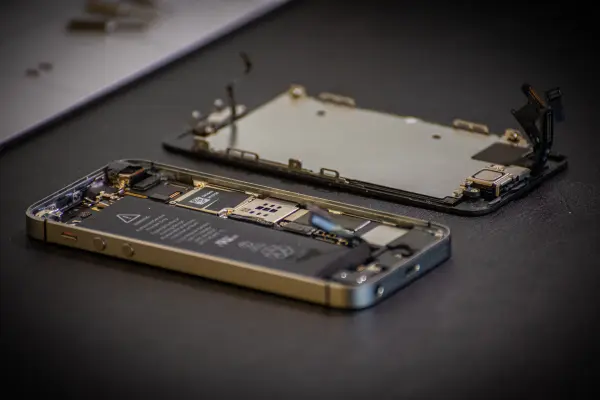Apple has produced updated variants of the iPhone, all of which include a back glass that is quite fashionable. Since the release of the iPhone 8, the old plastic back has been swapped out for a smooth and sparkly glass panel. The new iPhone’s back glass isn’t only smart, it now supports wireless charging.
While the new glass coating looks and feels elegant, it actually reduces grip, leading to an increase in the number of spills.
While a cracked iPhone screen used to be the major issue after a drop or slip, in which case a user would need to pay a significant Cost for an iPhone Screen Replacement, the back glass is now just as likely to get damaged.

Why Does Your iPhone Back Glass Need to be Replaced?
The need to replace the back glass on your iPhone can arise due to several factors. First and foremost, accidental drops and impacts can lead to cracks or shattered glass, compromising the structural integrity and aesthetics of your device.
Furthermore, exposure to environmental elements, like dust and moisture, can seep into these cracks, causing internal damage to the phone.
In addition, wear and tear over time, including scratches and scuffs, may necessitate replacement for a sleek appearance and to prevent further damage. And most important of all, some users opt for replacement to accommodate customisation preferences, such as choosing a different colour or adding wireless charging capabilities.
All in all, back glass replacement ensures the functionality and visual appeal of your iPhone.
How to do iPhone Back Glass Replacement (DIY)?
Replacing the back glass of an iPhone is a daunting task that requires technical skill and precision. It’s recommended to have this repair performed by professionals at an authorised service centre. However, if you’re determined to attempt it yourself, here’s a general guide for informational purposes only.
Please be aware that DIY back glass replacement can void your warranty and risk further damage if not done correctly.
- Ensure your device is powered off and disconnected from any power source.
- Unscrew the Pentalobe screws securing the frame and then the Phillips screws around the edges of the device.
- Use a heat gun or hair dryer to gently warm the back glass. This softens the adhesive.
- Insert plastic picks or spudgers carefully between the old back glass and the phone’s frame. Gently separate the glass from the frame.
- Take your time to disconnect any cables or components attached to the back glass. And now, lift off the old glass panel.
- Remove any remaining adhesive and clean the phone frame with adhesive remover and isopropyl alcohol.
- Apply the adhesive to the phone frame, following the manufacturer’s instructions.
- Carefully attach the new back glass and firmly press it onto the frame.
- Reconnect all cables and components. And now, reverse the disassembly process.
- Power on your iPhone and check for functionality.
Things to Consider Before DIY
Before going for a DIY iPhone back glass replacement, consider these essential factors. First, assess your technical skill and experience with electronics repairs, as this is a complex task. Research the specific tools, replacement parts, and adhesives needed.
Ensure you have a clean, dust-free workspace and appropriate safety equipment, like heat-resistant gloves and safety glasses. Next, review comprehensive, model-specific repair guides and videos for a step-by-step understanding. Be aware that self-repair might void warranties or cause irreparable damage.
Finally, exercise patience and caution throughout the process, as even a minor error can lead to costly consequences. But if you are in any doubt, consult a professional technician with immediate effects.

How much does iPhone Back Glass Replacement Cost in the UK?
The cost of repairing the back glass on the iPhone 15 Pro has seen a significant reduction compared to its predecessor, the iPhone 14 Pro. Apple recently released price estimates for its latest phones, indicating that the repair price for replacing the shattered back glass on the 15 Pro is £169, while the Pro Max is priced at £199.
This marks a meaningful decrease of up to £350 when compared to the repair costs for the previous year’s models. In the case of the iPhone 14 Pro and 14 Pro Max, Apple had charged an exorbitant £499 and £549 for back glass replacement, which, frankly, exceeded the cost of a new iPhone SE, despite its lower-end specifications.
The significant price reductions can be attributed to a significant design shift implemented by Apple in its latest phone models.
Unlike earlier versions where the back glass was deeply integrated into the device’s body, the newest iPhone models allow for the independent removal and replacement of the back glass. Previously, repairing the back glass on iPhones was considered one of the most costly and intricate repair procedures.
Apple initially introduced this design change with the iPhone 14 and 14 Plus models, and this year, they extended the same modification to the 15 Pro models.
This development is indeed excellent news for individuals who frequently experience the frustration of a cracked phone screen.
It’s worth noting that repair costs are even more economical if you opt for Apple’s insurance plan, which is priced at £199 for two years of coverage on the new Pro and Pro Max models, with a mere £29 fee for back glass repair. However, it’s essential to purchase this coverage in advance.
Back Glass Replacement Options in the UK
- Apple Store or Authorised Service Provider
Apple offers repair services for iPhones, including back glass replacement. You can visit an Apple Store or an authorised service provider for professional and warranty-preserving repairs.
- Third-Party Repair Shops
There are numerous third-party repair shops and mobile repair services across the UK that specialise in iPhone repairs. Ensure they have a good reputation and use high-quality replacement parts.
- DIY Kits
You can purchase back glass replacement kits online, but be cautious, as DIY repairs can void warranties and carry risks if not done correctly.
How to Avoid Back Glass Damage in the Future?
Protecting your iPhone should always be your top priority, and the best way to do so is with a sturdy cover. A strong or durable case will protect your device from potential harm in the event of future drops or fumbles.
Tempered glass is an appropriate alternative. When it comes to protecting your iPhone’s display, tempered glass is a common choice. However, tempered glass on the back of a phone may shield it from more harm.
The Last Word
DIY repairs have the potential to save money, but they also carry the risk of failure or even serious harm to the phone. Many of the do-it-yourself repairs people attempt to end up breaking the camera or the case.
Having a professional replace the rear glass on your iPhone is not only inexpensive, but it also guarantees that your phone will continue to look and work like new for years to come.
FAQ’s
Should You Repair an iPhone yourself?
Most likely not. Since almost all modern smartphones have readily detachable back panels, doing DIY repairs on your own device may be a stressful and difficult process.
There are evident safety considerations involved if you don’t know precisely what you’re doing, and there’s a chance that you may end up doing more damage to your mobile device than good.
Should I Consider Buying a Refurbished iPhone if the Repair Cost is higher?
As an alternative to paying a hefty out-of-warranty repair cost, you might consider purchasing a refurbished replacement smartphone.
We have a list of the Best Places to Buy Refurbished Smartphones in the UK. You may be in a better position than with your current phone if you purchase a refurbished one that has been officially certified by the manufacturer or merchant.
